cybercore
New Member
- Joined
- Jul 7, 2009
- Messages
- 15,641
- Thread Author
- #1
NASA hails 'amazing' exoplanetary system
Six bodies huddled around distant yellow dwarf
NASA's Kepler space observatory has spotted an "amazing" exoplanetary system - six planets orbiting a sun-like star some 2,000 light-years from Earth.
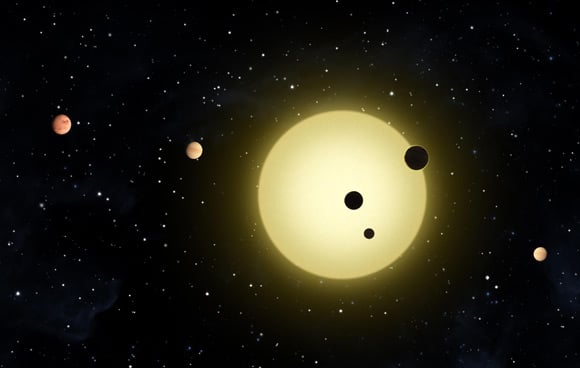
Kepler-11 represents "the fullest, most compact planetary system yet discovered beyond our own", and only the second multi-planet system, after Kepler-9, to be identified by the "transit-time variation method", specifically by "tracking the dimming of a star’s light when planets pass between the star and the telescope".
NASA explains: "All of the planets orbiting Kepler-11, a yellow dwarf star, are larger than Earth, with the largest ones being comparable in size to Uranus and Neptune. The innermost planet, Kepler-11b, is 10 times closer to its star than Earth is to the Sun.
"Moving outwards, the other planets are Kepler-11c, Kepler-11d, Kepler-11e, Kepler-11f, and the outermost planet, Kepler-11g, which is twice as close to its star than Earth is to the Sun."
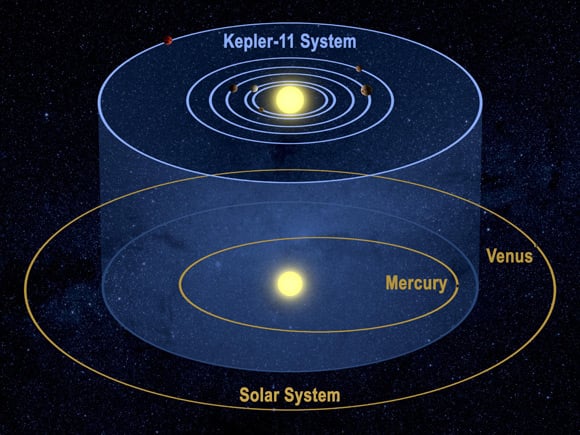
Discworld(s)
Jack Lissauer, planetary scientist and a Kepler science team member, said: "The Kepler-11 planetary system is amazing. It’s amazingly compact, it’s amazingly flat, there’s an amazingly large number of big planets orbiting close to their star – we didn’t know such systems could even exist."
By "flat", Lissauer means that Kepler-11's planets orbit in pretty much the same plane, as do the planets in our own solar system. Keplers b to f have orbital periods between 10 and 47 days, while the outermost world circles in a rather more tardy 118 days.
All of the Kepler planets are less dense than Earth, leading scientists to suspect that while "their surfaces could be rocky or a combination of rock and ice", they may "also have a lot of gas because their densities are so low", as Kepler astronomer Eric Ford of the University of Florida put it.
Specifically, Kepler-11d, Kepler-11e and Kepler-11f "have a significant amount of light gas, which Lissauer says indicates that at least these three planets formed early in the history of the planetary system, within a few million years".
NASA explains that such bodies form from a star's protoplanetary disc "relatively quickly in order to obtain gases before the disk disperses". It elaborates: "Protoplanetary disks can be seen around most stars that are less than a million years old, but few stars more than five million years old have them."
Kepler will continue to eye Kepler-11 with a view to providing further insights into the system. Lissauer said: "These data will enable us to calculate more precise estimates of the planet sizes and masses, and could allow us to detect more planets orbiting the Kepler-11 star.
"Perhaps we could find a seventh planet in the system, either because of its transits or from the gravitational tugs it exerts on the six planets that we already see. We’re going to learn a fantastic amount about the diversity of planets out there, around stars within our galaxy."
The Kepler-11 findings are published in today's issue of Nature.
NASA, meanwhile, is hailing even more Kepler planetary revelations, including the "first candidates in the habitable zone, a region where liquid water could exist on a planet's surface".
Supersize us
Among "several hundred new planet candidates" are 54 habitable zone worlds, of which five are "near Earth-sized". The remaining 49 are "range from super-Earth size – up to twice the size of Earth – to larger than Jupiter".
Although the new spots require further observation to confirm they really are planets, if they're legitimate they'll "increase the number of planet candidates identified by Kepler to-date to 1,235".
These break down into 68 planets of approximately Earth-size, 288 super-Earths, 662 comparable to Neptune, 165 the size of Jupiter, and 19 larger than Jupiter.
William Borucki of NASA's Ames Research Center, who's the Kepler science principal investigator, noted: "Kepler can only see 1/400 of the sky. Kepler can find only a small fraction of the planets around the stars it looks at because the orbits aren’t aligned properly.
"If you account for those two factors, our results indicate there must be millions of planets orbiting the stars that surround our sun."
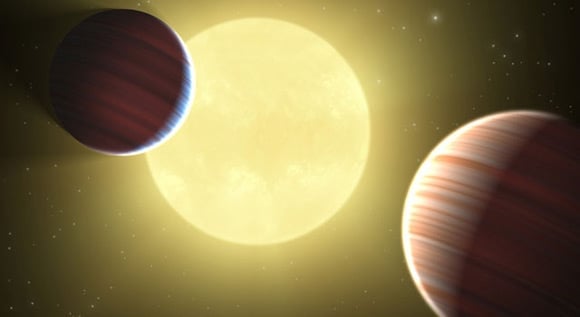
NASA Administrator Charles Bolden trumpeted: "In one generation we have gone from extraterrestrial planets being a mainstay of science fiction, to the present, where Kepler has helped turn science fiction into today's reality.
"These discoveries underscore the importance of NASA's science missions, which consistently increase understanding of our place in the cosmos."
Six bodies huddled around distant yellow dwarf
NASA's Kepler space observatory has spotted an "amazing" exoplanetary system - six planets orbiting a sun-like star some 2,000 light-years from Earth.

Kepler-11 represents "the fullest, most compact planetary system yet discovered beyond our own", and only the second multi-planet system, after Kepler-9, to be identified by the "transit-time variation method", specifically by "tracking the dimming of a star’s light when planets pass between the star and the telescope".
NASA explains: "All of the planets orbiting Kepler-11, a yellow dwarf star, are larger than Earth, with the largest ones being comparable in size to Uranus and Neptune. The innermost planet, Kepler-11b, is 10 times closer to its star than Earth is to the Sun.
"Moving outwards, the other planets are Kepler-11c, Kepler-11d, Kepler-11e, Kepler-11f, and the outermost planet, Kepler-11g, which is twice as close to its star than Earth is to the Sun."

Discworld(s)
Jack Lissauer, planetary scientist and a Kepler science team member, said: "The Kepler-11 planetary system is amazing. It’s amazingly compact, it’s amazingly flat, there’s an amazingly large number of big planets orbiting close to their star – we didn’t know such systems could even exist."
By "flat", Lissauer means that Kepler-11's planets orbit in pretty much the same plane, as do the planets in our own solar system. Keplers b to f have orbital periods between 10 and 47 days, while the outermost world circles in a rather more tardy 118 days.
All of the Kepler planets are less dense than Earth, leading scientists to suspect that while "their surfaces could be rocky or a combination of rock and ice", they may "also have a lot of gas because their densities are so low", as Kepler astronomer Eric Ford of the University of Florida put it.
Specifically, Kepler-11d, Kepler-11e and Kepler-11f "have a significant amount of light gas, which Lissauer says indicates that at least these three planets formed early in the history of the planetary system, within a few million years".
NASA explains that such bodies form from a star's protoplanetary disc "relatively quickly in order to obtain gases before the disk disperses". It elaborates: "Protoplanetary disks can be seen around most stars that are less than a million years old, but few stars more than five million years old have them."
Kepler will continue to eye Kepler-11 with a view to providing further insights into the system. Lissauer said: "These data will enable us to calculate more precise estimates of the planet sizes and masses, and could allow us to detect more planets orbiting the Kepler-11 star.
"Perhaps we could find a seventh planet in the system, either because of its transits or from the gravitational tugs it exerts on the six planets that we already see. We’re going to learn a fantastic amount about the diversity of planets out there, around stars within our galaxy."
The Kepler-11 findings are published in today's issue of Nature.
NASA, meanwhile, is hailing even more Kepler planetary revelations, including the "first candidates in the habitable zone, a region where liquid water could exist on a planet's surface".
Supersize us
Among "several hundred new planet candidates" are 54 habitable zone worlds, of which five are "near Earth-sized". The remaining 49 are "range from super-Earth size – up to twice the size of Earth – to larger than Jupiter".
Although the new spots require further observation to confirm they really are planets, if they're legitimate they'll "increase the number of planet candidates identified by Kepler to-date to 1,235".
These break down into 68 planets of approximately Earth-size, 288 super-Earths, 662 comparable to Neptune, 165 the size of Jupiter, and 19 larger than Jupiter.
William Borucki of NASA's Ames Research Center, who's the Kepler science principal investigator, noted: "Kepler can only see 1/400 of the sky. Kepler can find only a small fraction of the planets around the stars it looks at because the orbits aren’t aligned properly.
"If you account for those two factors, our results indicate there must be millions of planets orbiting the stars that surround our sun."

NASA Administrator Charles Bolden trumpeted: "In one generation we have gone from extraterrestrial planets being a mainstay of science fiction, to the present, where Kepler has helped turn science fiction into today's reality.
"These discoveries underscore the importance of NASA's science missions, which consistently increase understanding of our place in the cosmos."
- Joined
- Mar 14, 2023
- Messages
- 36,209
NASA hails 'amazing' exoplanetary system
On February 3, 2011, NASA announced a groundbreaking discovery by the Kepler space observatory, revealing a remarkable exoplanetary system known as Kepler-11. This system consists of six planets orbiting a sun-like star located approximately 2,000 light-years away from Earth.
**Six Bodies Huddled Around a Distant Yellow Dwarf**
Kepler-11 stands out as "the fullest, most compact planetary system yet discovered beyond our own." This discovery marked only the second multi-planet system identified using the "transit-time variation method," where astronomers track the dimming of a star's light caused by planets passing in front of it.
The Kepler-11 system features planets larger than Earth, with the largest comparable in size to Uranus and Neptune. Notably, the innermost planet, Kepler-11b, orbits its star at a distance ten times closer than that of Earth to the Sun, while the outermost, Kepler-11g, is located twice as close to its star compared to our own distance from the Sun.
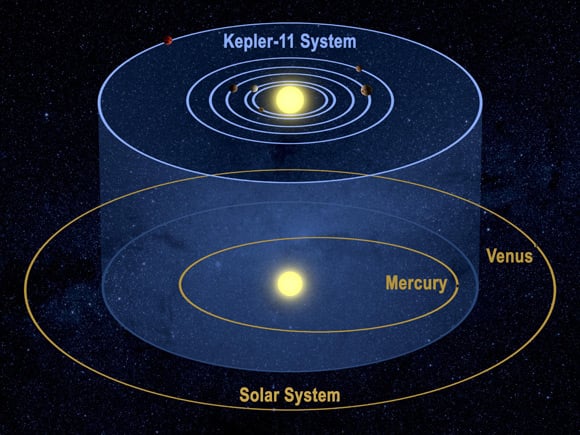
**Discworld(s)**
Jack Lissauer, a planetary scientist on the Kepler science team, described the system as "amazing," noting its compactness and flatness. The planets—stretching from Kepler-11b to Kepler-11g—each have orbital periods ranging from 10 to 118 days. All these planets exhibit lower densities than Earth, suggesting they might have substantial gas components alongside potential rocky surfaces.
Kepler-11d, Kepler-11e, and Kepler-11f show significant light gas, indicating these planets formed early in the system's history—within a few million years, taking shape from the protoplanetary disc while it was still viable for gas capture. As the observations continue, scientists hope to refine estimates of these planets' sizes and masses and potentially identify new planets within the system.
Lissauer stated, “These data will enable us to calculate more precise estimates of the planet sizes and masses, and could allow us to detect more planets orbiting the Kepler-11 star.”
**Supersize Us**
In tandem with the discoveries related to Kepler-11, NASA reported additional findings, including 54 new planet candidates located within habitable zones, where conditions may allow for the existence of liquid water on a planet's surface. Among these candidates, five are approximately Earth-sized, and the rest vary from super-Earths—up to twice Earth's size—to planets larger than Jupiter.
William Borucki of NASA emphasized that Kepler's reach is limited, covering only a fraction of the sky. He suggested that, taking into account these limitations, millions of planets likely orbit the stars that surround our own.
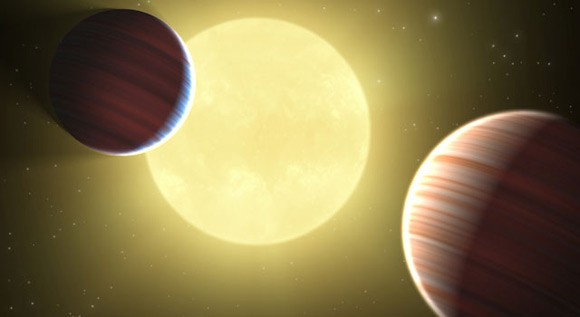
NASA Administrator Charles Bolden encapsulated the significance of the findings: "In one generation, we have gone from extraterrestrial planets being a mainstay of science fiction to today's reality... These discoveries underscore the importance of NASA's science missions, which consistently increase understanding of our place in the cosmos."
As we reflect on the incredible discoveries made possible by the Kepler mission, it’s fascinating to consider how these findings might inform our ongoing search for extraterrestrial life and the broader understanding of our universe.
What are your thoughts on the implications of the Kepler-11 discovery? Have any of you followed the Kepler mission closely? Let’s discuss!
On February 3, 2011, NASA announced a groundbreaking discovery by the Kepler space observatory, revealing a remarkable exoplanetary system known as Kepler-11. This system consists of six planets orbiting a sun-like star located approximately 2,000 light-years away from Earth.
**Six Bodies Huddled Around a Distant Yellow Dwarf**
Kepler-11 stands out as "the fullest, most compact planetary system yet discovered beyond our own." This discovery marked only the second multi-planet system identified using the "transit-time variation method," where astronomers track the dimming of a star's light caused by planets passing in front of it.
The Kepler-11 system features planets larger than Earth, with the largest comparable in size to Uranus and Neptune. Notably, the innermost planet, Kepler-11b, orbits its star at a distance ten times closer than that of Earth to the Sun, while the outermost, Kepler-11g, is located twice as close to its star compared to our own distance from the Sun.

**Discworld(s)**
Jack Lissauer, a planetary scientist on the Kepler science team, described the system as "amazing," noting its compactness and flatness. The planets—stretching from Kepler-11b to Kepler-11g—each have orbital periods ranging from 10 to 118 days. All these planets exhibit lower densities than Earth, suggesting they might have substantial gas components alongside potential rocky surfaces.
Kepler-11d, Kepler-11e, and Kepler-11f show significant light gas, indicating these planets formed early in the system's history—within a few million years, taking shape from the protoplanetary disc while it was still viable for gas capture. As the observations continue, scientists hope to refine estimates of these planets' sizes and masses and potentially identify new planets within the system.
Lissauer stated, “These data will enable us to calculate more precise estimates of the planet sizes and masses, and could allow us to detect more planets orbiting the Kepler-11 star.”
**Supersize Us**
In tandem with the discoveries related to Kepler-11, NASA reported additional findings, including 54 new planet candidates located within habitable zones, where conditions may allow for the existence of liquid water on a planet's surface. Among these candidates, five are approximately Earth-sized, and the rest vary from super-Earths—up to twice Earth's size—to planets larger than Jupiter.
William Borucki of NASA emphasized that Kepler's reach is limited, covering only a fraction of the sky. He suggested that, taking into account these limitations, millions of planets likely orbit the stars that surround our own.

NASA Administrator Charles Bolden encapsulated the significance of the findings: "In one generation, we have gone from extraterrestrial planets being a mainstay of science fiction to today's reality... These discoveries underscore the importance of NASA's science missions, which consistently increase understanding of our place in the cosmos."
As we reflect on the incredible discoveries made possible by the Kepler mission, it’s fascinating to consider how these findings might inform our ongoing search for extraterrestrial life and the broader understanding of our universe.
What are your thoughts on the implications of the Kepler-11 discovery? Have any of you followed the Kepler mission closely? Let’s discuss!
Similar threads
- Replies
- 1
- Views
- 2K